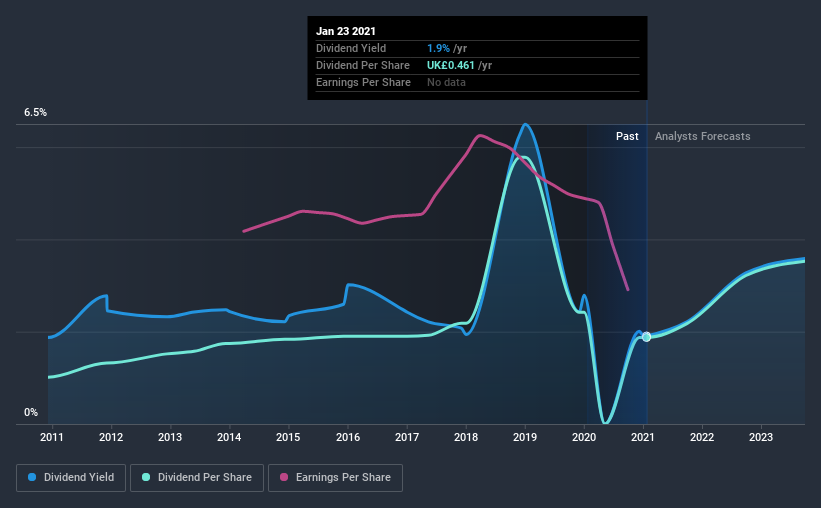Here's Why We're Wary Of Buying Victrex's (LON:VCT) For Its Upcoming Dividend
Victrex plc (LON:VCT) stock is about to trade ex-dividend in four days. If you purchase the stock on or after the 28th of January, you won't be eligible to receive this dividend, when it is paid on the 19th of February.
Victrex's next dividend payment will be UK£0.46 per share. Last year, in total, the company distributed UK£0.46 to shareholders. Calculating the last year's worth of payments shows that Victrex has a trailing yield of 1.9% on the current share price of £24.2. If you buy this business for its dividend, you should have an idea of whether Victrex's dividend is reliable and sustainable. That's why we should always check whether the dividend payments appear sustainable, and if the company is growing.
View our latest analysis for Victrex
Dividends are typically paid out of company income, so if a company pays out more than it earned, its dividend is usually at a higher risk of being cut. Victrex is paying out an acceptable 74% of its profit, a common payout level among most companies. A useful secondary check can be to evaluate whether Victrex generated enough free cash flow to afford its dividend. Over the last year, it paid out more than three-quarters (90%) of its free cash flow generated, which is fairly high and may be starting to limit reinvestment in the business.
It's encouraging to see that the dividend is covered by both profit and cash flow. This generally suggests the dividend is sustainable, as long as earnings don't drop precipitously.
Click here to see the company's payout ratio, plus analyst estimates of its future dividends.
Have Earnings And Dividends Been Growing?
When earnings decline, dividend companies become much harder to analyse and own safely. If earnings decline and the company is forced to cut its dividend, investors could watch the value of their investment go up in smoke. Readers will understand then, why we're concerned to see Victrex's earnings per share have dropped 8.6% a year over the past five years. When earnings per share fall, the maximum amount of dividends that can be paid also falls.
Many investors will assess a company's dividend performance by evaluating how much the dividend payments have changed over time. In the last 10 years, Victrex has lifted its dividend by approximately 6.3% a year on average. That's interesting, but the combination of a growing dividend despite declining earnings can typically only be achieved by paying out more of the company's profits. This can be valuable for shareholders, but it can't go on forever.
The Bottom Line
From a dividend perspective, should investors buy or avoid Victrex? While earnings per share are shrinking, it's encouraging to see that at least Victrex's dividend appears sustainable, with earnings and cashflow payout ratios that are within reasonable bounds. With the way things are shaping up from a dividend perspective, we'd be inclined to steer clear of Victrex.
With that in mind though, if the poor dividend characteristics of Victrex don't faze you, it's worth being mindful of the risks involved with this business. For example - Victrex has 2 warning signs we think you should be aware of.
A common investment mistake is buying the first interesting stock you see. Here you can find a list of promising dividend stocks with a greater than 2% yield and an upcoming dividend.
This article by Simply Wall St is general in nature. It does not constitute a recommendation to buy or sell any stock, and does not take account of your objectives, or your financial situation. We aim to bring you long-term focused analysis driven by fundamental data. Note that our analysis may not factor in the latest price-sensitive company announcements or qualitative material. Simply Wall St has no position in any stocks mentioned.
Have feedback on this article? Concerned about the content? Get in touch with us directly. Alternatively, email editorial-team (at) simplywallst.com.

 Yahoo Finance
Yahoo Finance 
